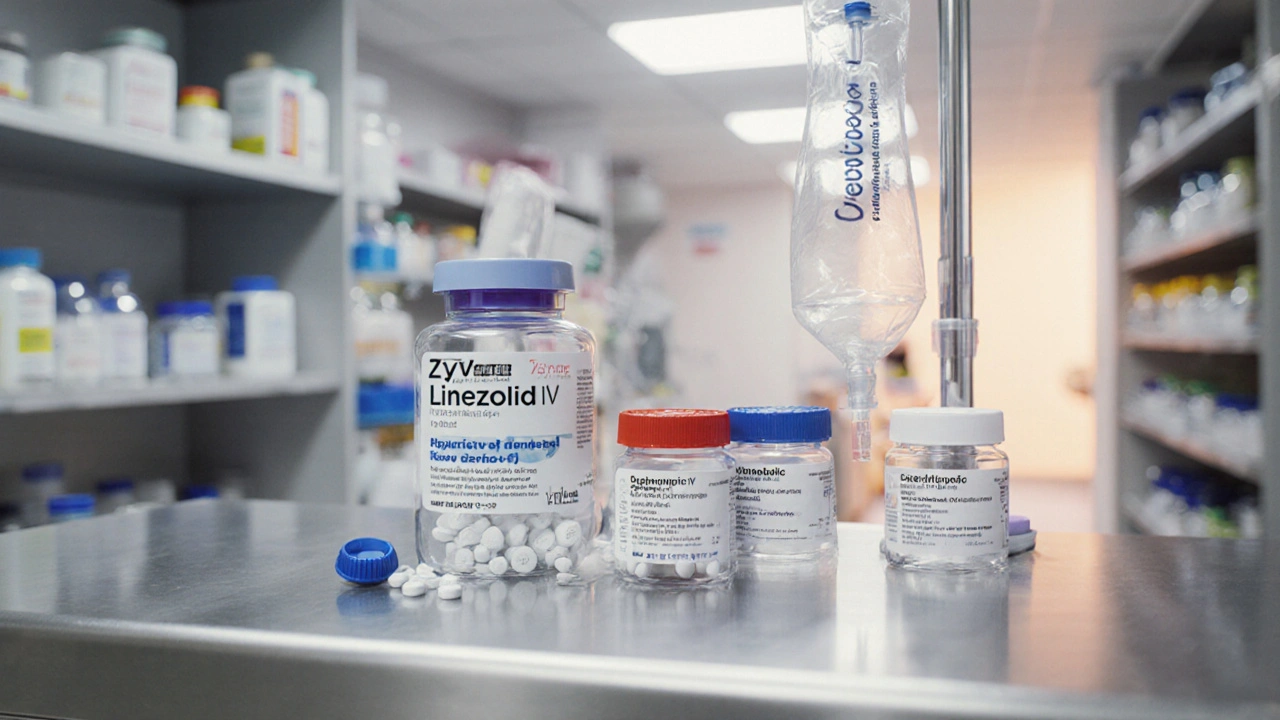Zyvox (Linezolid) – Uses, Dosage, and Safety
When working with Zyvox, the brand name for the antibiotic linezolid, used to treat serious gram‑positive infections. Also known as linezolid, it belongs to the oxazolidinone class of antibiotics, a group prized for its ability to bypass many common resistance mechanisms. This makes Zyvox a go‑to option when doctors face tough bugs like MRSA or VRE.
Why does Zyvox matter in everyday practice? First, its mechanism – it blocks the bacterial ribosome, halting protein production. That simple action translates into a broad spectrum against stubborn gram‑positive organisms. Second, the drug is available both as oral tablets and IV infusion, giving clinicians flexibility for hospital stays and at‑home therapy. Finally, the safety profile is well‑documented: common side effects include nausea and headache, while rare but serious concerns involve blood‑cell suppression and serotonin syndrome when combined with certain antidepressants.
Key Factors That Influence Zyvox Prescribing
Understanding when to reach for Zyvox starts with recognizing antibiotic resistance, a rising global health challenge. When standard drugs like vancomycin or beta‑lactams fail, physicians often turn to linezolid because it sidesteps many resistance genes. Another deciding factor is the infection site. Zyvox penetrates lung tissue well, making it effective for community‑acquired pneumonia caused by resistant Streptococcus pneumoniae. It also reaches bone and joint spaces, so doctors use it for osteomyelitis when other options are limited.
Dosage isn’t one‑size‑fits‑all. The typical adult regimen is 600 mg every 12 hours, either orally or IV. For children, weight‑based dosing applies, and adjustments are needed for patients with renal or hepatic impairment. Monitoring is crucial: CBC checks every 1‑2 weeks catch early signs of thrombocytopenia, and liver‑function tests help avoid hidden toxicity. If you’re on selective‑serotonin reuptake inhibitors (SSRIs) or other serotonergic meds, a pharmacist should review the combo to prevent serotonin syndrome.
How does Zyvox compare with other antibiotics featured in our collection? Take Levaquin (levofloxacin) – a fluoroquinolone that works well for many gram‑negative infections but carries a higher risk of tendon rupture and QT prolongation. Or Roxithromycin, a macrolide suited for atypical pneumonia but less potent against MRSA. Zyvox fills a niche where those drugs fall short, especially for hospital‑acquired infections that resist first‑line therapy.
Cost is another practical angle. Zyvox isn’t cheap, and insurance coverage varies widely. That’s why many patients explore reputable online pharmacies for affordable generic linezolid options. When you shop online, verify the pharmacy’s license, compare prices, and read user reviews – a process we detail in several of our guides. Remember, a lower price isn’t worth a counterfeit pill that could jeopardize your health.
Beyond the drug itself, the broader treatment plan matters. Successful infection control pairs Zyvox with proper wound care, source control (like draining an abscess), and infection‑prevention measures such as hand hygiene and contact precautions. In chronic conditions like diabetic foot infections, a multidisciplinary team – surgeon, infectious‑disease specialist, and pharmacist – maximizes the chance of cure while limiting side‑effect exposure.
For patients worried about side effects, here are quick tips: take Zyvox with food to ease stomach upset, stay hydrated, and avoid alcohol if you have liver disease. If you notice unusual bruising, fatigue, or breathlessness, contact your doctor right away. Those could signal blood‑cell issues that need dose adjustment or a switch to another agent.
Looking ahead, research is testing shorter courses of linezolid to reduce toxicity while keeping efficacy high. Early studies suggest a 10‑day course may be as good as the traditional 14‑day regimen for certain skin infections. Keep an eye on clinical trials – they could change prescribing habits and make Zyvox safer for long‑term use.
All of this information sets the stage for the collection of articles you’ll find below. We’ve gathered practical guides on buying affordable generics, comparing antibiotics, managing side effects, and navigating specific infections. Whether you’re a patient hunting for cost‑saving tips or a clinician brushing up on the latest dosing guidelines, the posts ahead cover the breadth of topics that intersect with Zyvox and its role in modern therapy.
A comprehensive side‑by‑side comparison of Zyvox (Linezolid) with its main alternatives, covering spectrum, dosing, safety, cost and best‑use scenarios for clinicians.

